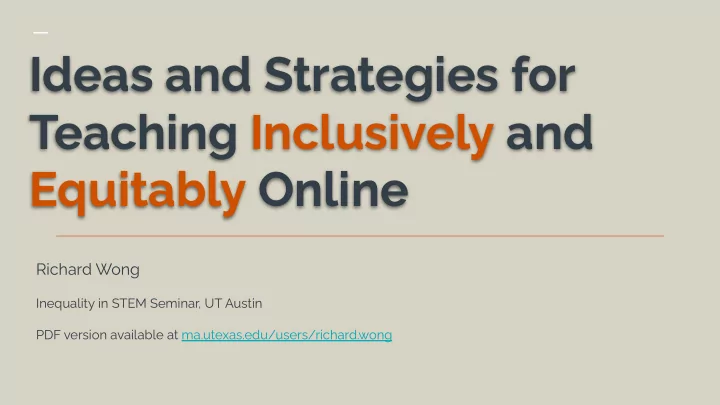

Ideas and Strategies for Teaching Inclusively and Equitably Online Richard Wong Inequality in STEM Seminar, UT Austin PDF version available at ma.utexas.edu/users/richard.wong
Let us acknowledge that the land UT Austin sits on is the unceded traditional territory of a number of Indigenous peoples, including the Tonkawa, the Lipan Apache, and the Comanche. They were subject to systematic attack and murder at the hands of Texan colonists throughout the 19th Century, and they were forcibly removed from Texas in 1859. We acknowledge the reparations owed to these communities and nations, and let us honor them by taking a moment of silence to reflect on what needs to be done, and what we can do.
The key ideas in this seminar come from a CORA webinar given by: Dr. J. Luke Wood Dr. Frank Harris III
As well as resources from the UT Austin FIC, and conversations with Dr. Laura Struve
As TAs, how can we make our online teaching inclusive and equitable?
Using Zoom is not enough. You should not teach online the same way as you would teach in person.
Tenets for ❖ Accessibility ❖ Building Inclusive and Community Equitable ❖ Intervention ❖ Empathy & Race- Teaching Consciousness
Accessibility ❖ Anonymously survey students about their resources and needs. What technology/software do they have access to? ➢ Do they have reliable internet access? ➢ Do they have a quiet/safe workspace? ➢ Are there accommodations they might need? ➢ What are the student’s course goals? ➢ ❖ Use transcription services: Google Slides, Powerpoint, Youtube, Zoom ➢ UT Austin transcription services ➢
Accessibility ❖ Use synchronous and asynchronous materials and activities. This does not just mean recording Zoom lectures. ➢ Offer low-data, accessible, and mobile-friendly materials ➢ (such as pdfs). Make use of website discussion tools like Canvas/Piazza ➢ ❖ For synchronous activities: Use active learning techniques. ➢ Split sessions into smaller (5-15 minute) segments. ➢ Vary the activities and techniques you use. ➢
The “Community of Inquiry” model for (online) learning.
The “Community of Inquiry” model considers three main types of student interactions in (online) learning: ❖ Student - Course Material ❖ Student - Peers ❖ Student - Instructor
Building Community ❖ Build student communities that exist beyond class hours: Zoom breakout rooms are not enough! ➢ Encourage collaboration using Google docs, Canvas, ➢ Groupme, etc. ❖ Encourage participation in office hours, CalcLab, Sanger tutoring, etc. Encourage students to attend in groups. ➢ ❖ Encourage use of Social Contracts.
How else can we improve accessibility and build community?
Intervention ❖ Reach out to students before they are at risk of dropping or failing: Track participation weekly through low or no-stakes ➢ check-ins: Use Instapoll, Canvas posts, etc. ■ Message students that stop participating! ➢ ❖ Continue to survey students about their needs. Re-evaluate goals biweekly or monthly. ➢
Empathy & Race-consciousness ❖ Acknowledge the difficulties of the pandemic. Know that it affects people in different ways. ➢ Promote self-care resources. ➢ ❖ Be accommodating/flexible. ❖ Be available: Have regular office hours. ➢ Respond to emails/messages promptly. ➢
Empathy & Race-consciousness ❖ Be aware of your own actions: Validate, affirm, and empower your students. ➢ Avoid microaggressions. ➢ ❖ Be race-conscious in your examples: Kerala school of mathematics ➢ Maria Agnesi ➢ Katherine Johnson, Dorothy Vaughan, Mary Jackson ➢ Annie Easley ➢ Vivienne Malone-Mayes ➢ Maryam Mirzakhani ➢ Use examples from Living Proof ➢
How else can we intervene and be empathetic & race-conscious?
Tenets for ❖ Accessibility ❖ Building Inclusive and Community Equitable ❖ Intervention ❖ Empathy & Race- Teaching Consciousness
Further Resources and Readings: CORA- Equity-Minded and Culturally-Affirming Teaching and Learning ❖ Practices in Virtual Learning Communities Rice - Inclusion, Equity, and Access While Teaching Remotely ❖ Vanderbilt - Teaching in Times of Crisis ❖ FIC - The Commons ❖ FIC - Building Community in Online Classrooms ❖ Closing global achievement gaps in MOOCs ❖ Towards Equal Opportunities in MOOCs: Affirmation Reduces Gender & ❖ Social-class Achievement Gaps in China Latinxs and Hispanics in the Mathematical Sciences ❖ Mathematically Gifted & Black ❖ Living Proof: Stories of Resilience Along the Mathematical Journey ❖
Thanks for listening!
Recommend
More recommend